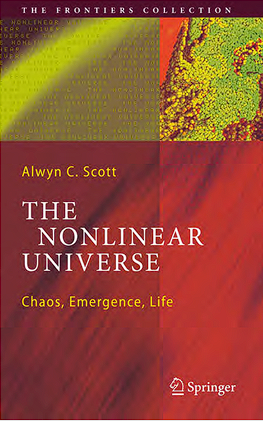
The_Nonlinear_Universe_-_Chaos_Emergence_Life
Author: Alwyn C. Scott Category: Matematika Terapan Publisher: Springer ISBN: 978-3-540-34152-9It has been suggested that the big questions of science are answered– that
science has entered a “twilight age” where all the important knowledge is
known and only the details need mopping up. And yet, the unprecedented
progress in science and technology in the twentieth century has raised ques
tions that weren’t conceived of a century ago. This book argues that, far
from being nearly complete, the story of science has many more chapters, yet
unwritten. With the perspective of the century’s advance, it’s as if we have
climbed a mountain and can see just how much broader the story is.
Instead of asking how an apple falls from a tree, as Isaac Newton did in
the 17th century, we can now ask: What is the fundamental nature of an apple
(matter)? How does an apple (biological organism) form and grow? Whence
came the breeze that blew it loose (meteorology)? What in a physical sense
(synaptic firings) was the idea that Newton had, and how did it form?
Anew approach to science that can answer such questions has sprung up
in the past 30 years. This approach– known as nonlinear science–ismore
than a new field. Put simply, it is the recognition that throughout nature,
the whole is greater than the sum of the parts. Unexpected things happen.
Minute causes can explode into mighty effects. Metaphorically, a butterfly
f
laps its wings in the Gobi Desert, causing a tornado in Texas. Nonlinear
science provides the tools to study these phenomena. It is a metascience, a
tree trunk that supports and governs the organization of almost every other
branch of inquiry. Like Copernicus putting the Sun at the center of the Solar
System, nonlinear science is a revolution. And just as Newton’s work offered a
basis for scientific discoveries in the three centuries that followed, so nonlinear
science will support research in the 21st century and beyond.
Yet for all of its usefulness, nonlinear science is not widely known. The
public still thinks Newton’s laws, and others of a similar nature, are suffi
cient to explain what causes a plane to crash or a cancer to grow. But this
reductionism, as will be shown, is inadequate to deal with the more intricate
questions of the 21st century.
Back